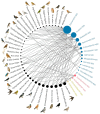Resisting the Final Line: Phenotypic Detection of Resistance to Last-Resort Antimicrobials in Gram-Negative Bacteria Isolated from Wild Birds in Northern Italy
- PMID: 40805079
- PMCID: PMC12345454
- DOI: 10.3390/ani15152289
Resisting the Final Line: Phenotypic Detection of Resistance to Last-Resort Antimicrobials in Gram-Negative Bacteria Isolated from Wild Birds in Northern Italy
Abstract
Antimicrobial resistance (AMR) is a growing global health threat, with wild birds increasingly recognized as potential reservoirs of resistant pathogens and as sentinels of environmental AMR. This study investigated the occurrence and AMR profiles of Gram-negative bacteria isolated from wild birds that died at the Wildlife Rescue Center in Vanzago, Lombardy, in 2024. Cloacal swabs were collected from 112 birds representing various ecological categories. A total of 157 Gram-negative bacteria were isolated and identified, including clinically relevant genera and species, such as Escherichia coli, Klebsiella pneumoniae, Enterobacter spp., Salmonella spp., Pseudomonas aeruginosa, and Acinetobacter baumannii. Antimicrobial susceptibility testing revealed resistance to first-line and critically important antimicrobials, including those exclusively authorized for human use. Notably, a phenotype compatible with Extended-Spectrum Beta-Lactamase (ESBL) production was detected in four out of ten (40%) K. pneumoniae isolates. In addition, 20 out of the 157 (12.7%) isolated bacteria phenotypically exhibited a resistance profile indicative of AmpC beta-lactamase (AmpC) production, including Enterobacter spp. and P. aeruginosa. Resistance patterns were particularly interesting in birds with carnivorous, scavenging, or migratory-associated behaviors. These findings highlight the role of wild birds in the ecology and dissemination of antimicrobial-resistant bacteria (ARB) and highlight the need for wildlife-based AMR monitoring programs as part of a One Health approach.
Keywords: AmpC; CIAs; ESBL; HCIAs; HPCIAs; One Health; antimicrobial resistance; last-line antimicrobials; wild birds.
Conflict of interest statement
The authors declare no conflicts of interest.
Figures


References
-
- WHO Ten Threats to Global Health in 2019. [(accessed on 14 April 2025)]. Available online: https://www.who.int/news-room/spotlight/ten-threats-to-global-health-in-....
-
- O’Neill J. The Review on Antimicrobial Resistance. Wellcome Trust; London, UK: 2014. Antimicrobial resistance: Tackling a crisis for the health and wealth of nations; pp. 1–16.
-
- WHO . Antimicrobial Resistance: Global Report on Surveillance. World Health Organization Press; Geneva, Switzerland: 2014. p. 256.
LinkOut - more resources
Full Text Sources
Miscellaneous

